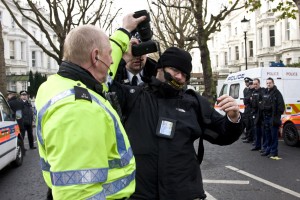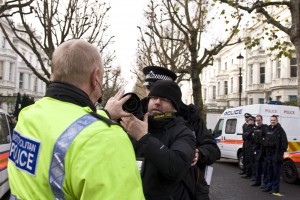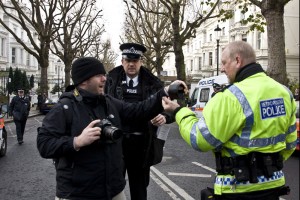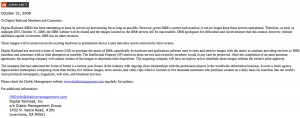Getty Images has announced the closure of citizen journalism photography site Scoopt, which it acquired in 2007.
Category Archives: Photography
Reuters blogs: Behind the pictures of the Hudson River plane crash
Gary Hershorn, Reuters News pictures editor for the Americas, gives a real sense of how it feels to chase breaking news in the post about how his team photographed the Hudson Rive plane crash.
Croydon Advertiser’s George Hoole – a slideshow retrospective
Wonderful audio slideshow reflecting the career of retiring photographer and Croydon Advertiser archivist George Hoole, who hangs up his camera next week.
Hoole, 63, who suffered a stroke 30 years ago, has worked in the industry for 34 years and talks about some of his favourite shots in conversation with Advertiser chief photographer David Berman (tip – click on the bottom right button to make it full screen):
Berman has also produced a video documenting how he set up the shoot for the slideshow hosted on the Advertiser’s off-site blog for multimedia reporting – sitbonzo.com.
NUJ speaks out against Met Police ‘heavy-handedness’ at Greek Embassy Protests
Further to our blog post this morning, showing police interfering with photojournalist Marc Valleé while he was attempting to photograph protests at the Greek Embassy on Monday, the National Union of Journalists (NUJ) has released a statement criticising the Metropolitan Police for the way they handled media coverage of the protests outside the Greek Embassy on Monday.
The NUJ said it had received reports that ‘at least one of its members suffered physical injury as a result of their handling by the police’.
“There are clear guidelines which discuss how the police should work with the media and officers policing demonstrations need to be made aware of their responsibilities. The police know very well our concerns around cases like this and it’s simply unacceptable for our members to continue to have problems when covering protests. Such basic infringements of our members’ rights must stop,” the release said.
“Heavy-handed policing meant journalists were prevented from doing their jobs as they tried to report on the protests which took place on Monday. Photographs from the protests show the police deliberately obstructing photographers in their work and journalists have complained of being physically removed from any area from which they could document events.”
“The police must remember that they have responsibilities towards the media,” said NUJ Legal Officer Roy Mincoff, in the release. “Even where a protest is itself illegal, the media have a right to report on events and the police should not be taking action with the intention of obstructing journalists in their work,” he added.
Journalism.co.uk is following up, and will report more when further information is received.
Police and photographers clash at Greek Embassy protests
Photographers reporting on a blockade of the Greek Embassy by Greek and British anarchists in London on Monday 8 December found themselves in conflict with police officers at the scene.
These photographs by Philip Caller (his other photos of the protest can be viewed here) document a police officer grabbing and lifting up photographic equipment hanging around the neck of photojournalist Marc Valleé.
Vallée, who has featured on Journalism.co.uk before in regards to his investigation of rights under the Terrorism Act 2000, also publishes the photos on his blog.
(Photos Philip Caller/ www.flickr.com/photos/filkaler/) (c) Philip Caller, 2008.)



Stop-and-search: new guidance for police treatment of photographers
As reported by theregister.co.uk and the British Journal of Photography, new terrorism guidance for police officers has been issued. The National Police Improvement Agency (NPIA) has released its update ‘Practice Advice’ on stop-and-search powers, with reference to the Terrorism Act 2000.
The advice includes guidance for police officers on how to deal with photographers, but is not final. It has now been circulated to forces for final comments. After further consulatation it will need to be endorsed by the Assosiation of Chief Police Offices. (ACPO) [information courtesy of photojournalist Marc Vallée]
This announcement follows up from Marc Vallée’s assessment of the situation here and here.
The guidance:
“The Terrorism Act 2000 does not prohibit people from taking photographs or digital images in an area where an authority under section 44 is in place. Officers should not prevent people taking photographs unless they are in an area where photography is prevented by other legislation.
“If officers reasonably suspect that photographs are being taken as part of hostile terrorist reconnaissance, a search under section 43 of the Terrorism Act 2000 or an arrest should be considered. Film and memory cards may be seized as part of the search, but officers do not have a legal power to delete images or destroy film.
“Although images may be viewed as part of a search, to preserve evidence when cameras or other devices are seized, officers should not normally attempt to examine them. Cameras and other devices should be left in the state they were found and forwarded to appropriately trained staff for forensic examination. The person being searched should never be asked or allowed to turn the device on or off because of the danger of evidence being lost or damaged.
“Film and memory cards may be seized as part of the search and images may be viewed as part of a search.”
Marc Vallée asks on his blog:

“What is going on here? Does Section 43 of the Terrorism Act 2000 override the long held journalistic protection of Special Procedure Material under the Police and Criminal Evidence Act (PACE)?
“As an article on the EPUK website put it last year: ‘Under the Police and Criminal Evidence Act, material such as a journalist’s notes, photographs, computer files or tapes are classified as Special Procedure Material, which have a higher level of protection than ordinary possessions.’
“Which means if the police want to look at such material then they would have to go in front of a judge and explain why.”
Pictured: A press photographer files images on the move as environmental activists march from the Camp for Climate Action to Kingsnorth Power Station Hoo, Kent, England on Saturday August 9 2008. 2,000 campaigners marched on the Power Station with the aim to shut it down for the day. (Photo Marc Vallée/marcvallee.co.uk) (c) Marc Vallée, 2008.
In the meantime, until further information is obtained, Ray Mincoff, the NUJ legal editor, has issued this statement:
“We welcome the publication of unequivocal guidance showing that the Terrorism Act does not prohibit the taking of photographs in public places.
“The authorities must now ensure that police officers are aware of the limits to their powers. It must also be made crystal clear that the right to seize film and memory cards can only be used in the very exceptional circumstances where there are strong grounds for suspecting someone of being a terrorist.
“If section 43 of the Act ends up being casually used by officers in the same slapdash manner as other parts of the legislation, it would seriously inhibit the ability of journalists to work in our cities. The police cannot routinely use anti-terror or other legislation to stop journalists in their lawful and proper work. Neither must they see these guidelines as a green light to seize journalistic material, the special nature of which is recognised by law.
“We will also be looking carefully at other aspects of the guidelines to assess other possible effects on civil liberties and the free press.”
UPDATE:
Marc Vallée wrote to the National Police Improvement Agency (NPIA).
“Under the Police and Criminal Evidence Act, material such as a journalist’s notes, photographs, computer files or tapes are classified as Special Procedure Material, which have a higher level of protection than ordinary possessions,” he wrote.
“What is the view of the NPIA on this in the context of stop-and-search powers like S43? Could a UK Press Card carrying photographer use Special Procedure Material to stop or limit the scope of a stop-and-search under S43? or S44?”
They responded:
“There has been no change to the law. These guidelines remind officers that they can only stop-and-search photographers in exceptional cases where they believe they are involved in some kind of terrorist information gathering activity.”
UPDATE TWO (02/12/08): the NPIA has now added this statement:
“The Practice Advice makes it clear that there has been no change in the law. Journalist material will continue to enjoy the higher level of protection offered under PACE.
“For example, if a police officer suspects that photographs are being taken as part of terrorist information gathering they will rightly investigate. But once the stopped person makes it clear that they are a journalist then this will usually reassure police that they have legitimate reasons for taking photographs.”
The Register: Advanced copy of new terror guidelines on photography
An advanced copy of guidelines on stop and search under the section 44 of the Terrorism Act 2000 states:
“The Terrorism Act 2000 does not prohibit people from taking photographs or digital images in an area where an authority under section 44 is in place. Officers should not prevent people taking photographs unless they are in an area where photography is prevented by other legislation.”
The draft Terrorism Act 2000 guidance: what’s happening?
Photojournalist Marc Vallée updates us on the implications of the terrorism laws, for photographers and journalists, over on our main site.
Today, the Home Office had intended to publish new operational guidance to the police on the use of stop and search powers under section 44 of the Terrorism Act 2000 for those taking photographs in public places.
Here you can read the details of the draft guidance, with Marc’s comments:
Details of the draft guidance, as originally published on his own blog:
“There is no power under the Terrorism Act 2000 to prohibit people from taking photographs or digital images in an area where an authority under section 44 is in place.
“If officers reasonably suspect that photographs are being taken as part of hostile terrorist reconnaissance then they should act appropriately, by searching the person under Section 43 of the Terrorism Act or making an arrest. Cameras, film and memory cards may be seized as evidence but there is no power for images to be deleted or film to be destroyed by officers.”
MV: What if section 43 with its powers to seize ‘cameras, film and memory cards’ is misused in the same way that section 44 has been misused by the police? Just think of the chilling effect this will have on photography in a public place.
Then, to Clause 75 (amended in committee – 22.10.08) of the new Counter-Terrorism Bill 2008.
(1) A person commits an offence who:
(a) elicits or attempts to elicit information about an individual who is or has been:
(i) a member of Her Majesty’s forces
(ii) a member of any of the intelligence services, or
(iii) a constable
MV: A ‘Constable’ is the legal term for all police officers. Elicits or attempts to elicit information: ‘does that include taking a photograph and publishing it?
(b) publishes or communicates any such information.
MV: You can get 10 years for this one! And I almost forgot, every police force in Britain is going to be equipped with mobile fingerprint scanners which will allow the police to carry out identity checks on people on the street. I think I’m going to need to get myself a desk job!
LATimes.com: Photographers score success with social media – without knowing it
Social media and image-sharing sites are boosting photgraphers’ popularity with online audiences – but are they aware of the exposure they’re getting?
Online train crash: aftermath of the Digital Railroad’s closure
It would be a terrifying discovery for a photographer: to find you had just a few days to retrieve all your data from an online photo archive.
That’s exactly what happened to users of the Digital Railroad (DRR), when the site found itself in financial trouble, as we reported on here the other week.
Vincent Lafloret describes over at his blog how, although he personally has not lost out (he uses PhotoShelter) he thinks what has happened is ‘shameful’ and ‘inexcusable’.
“…you add the fact that everyone will then try to download their content simultaneously – and your bandwidth will dwindle instantly – and your pretty much ensure the digital apocalypse…few if any will be able to retrieve all of their images in time – before the servers are shut down. This is utterly irresponsible of them – it’s completely reprehensible. It’s something they should revisit immediately.”
A message on the defunct site doesn’t provide much support:

This afternoon PaidContentUK reports that the site is now reviewing a buy-out offer, which could make the photos accessible again. According to PaidContent:
…”DRR’s adminstrator Diablo Management also said it had a letter of intent to buy the site’s hardware and software, with the suitor intending to make the photos accessible once again. Who’s the buyer? Diablo cryptically said it was a “20-year fixture” in the business that “owns a multi-agency digital media marketplace composing more than 25 million images, news stories, and video clips” which it licenses to 5,000 news media customers.”